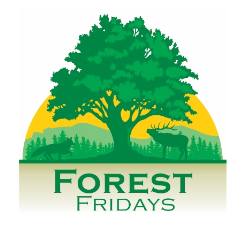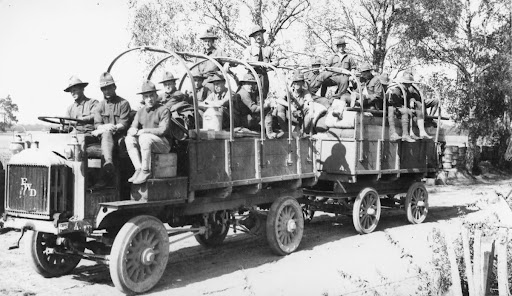Forest Fridays: Thank a veteran and thank a forestry veteran
Image above: Forestry Regiment troops moving camp, 1918 France. Forest History Society, Durham NC.
By John Schwartzer
Veterans Day calls on us to thank the members of our community that defend our American way of life. This Veterans Day we honor all the veterans who have served in our armed forces and the forests of the Commonwealth with a brief history of World War I and how it affected Pennsylvania’s forestry professionals.
The US entered the “German War” April 6, 1917. Most students and several instructors at the state-run Mont Alto Forest Academy enlisted. They were ideal enlistees due to their rugged outdoor occupation and exceptional fitness. A 1916 PA Forestry Commission report listed 71 total department employees.
Image: Mont Alto Forest Academy, Class of 1917. The Oak Leaf, 1915 to 1920.

By the end of 1917, 39 of the PA Forestry staff were in the armed forces. The annual report stated:
“War conditions have severely affected The Bureau of Silviculture. On January 1, 1916, our working force consisted of the forester in charge, one stenographer and ten assistants. By December 31, 1917, enlistments and resignations had reduced the bureau’s force to the forester in charge and the stenographer.”
Seven out of the eight 1917 Mont Alto graduates went into military service. During the two-year US involvement, forestry work continued on the home front. New metal fire towers were erected, wildfires were fought, and trees were grown, planted, and harvested.
Image: A call for enlistment for the Forestry Regiment. Forest History Society, Durham NC.
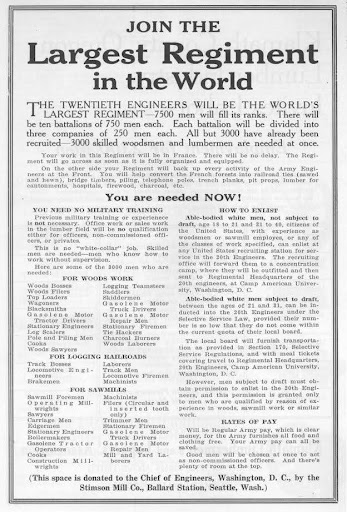
Large quantities of American wood were used in World War I for war-bound shipping containers, other wood products, and paper. In Europe, wood was used for military railway ties, bridges, dams, utility poles, firewood, and other construction needs. The largest amount of wood was supplied by the forests of Europe. Unbelievable amounts of lumber shored up trenches and bunkers as both sides battled in trench warfare. A total of 35,000 miles of trenches were constructed between the two sides, more than enough to circle the earth. If every trench had only a single 12-inch-wide plank, it would have used 185 million board feet.
Image: A newly constructed trench in 1918 France shows the amount of wood used in WWI trenches. Forest History Society, Durham NC.
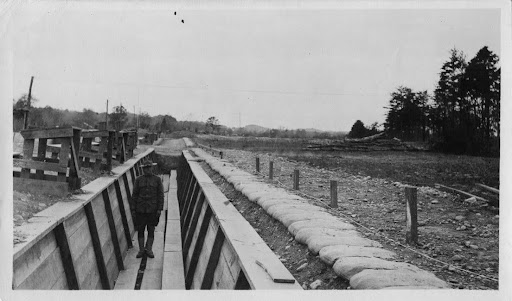
Many forestry professionals in the service were asked to do what they knew best — harvesting and milling Europe’s timber for the war efforts with what became the 20th Engineer Regiment. Twenty-four of the 39 forestry employees mentioned above, and many forestry students, went to the Engineers.
The 20th Engineers was known as the “Forestry Regiment”, eventually becoming the largest regiment in the US WWI Army. The foresters witnessed firsthand the benefits of Europe’s intensive forest management.
Image: Forestry Regiment loading logs, France 1918. Forest History Society, Durham NC
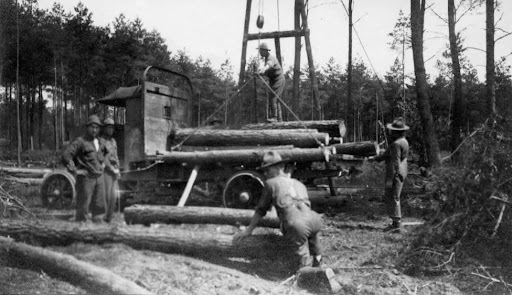
The first French logs milled by US soldiers were supervised by a Mont Alto graduate, Lieutenant John W. Seltzer. By October 1918, there were 81 Army mills supplied and operated by over 18,000 20th Engineers to produce 53 million board feet of lumber per month! –triple the expected capacity. The Bureau of Forestry only sells 70 million board feet of timber per year today.
Image: One of 81 US Army sawmills in operation, France 1918. Forest History Society, Durham NC.
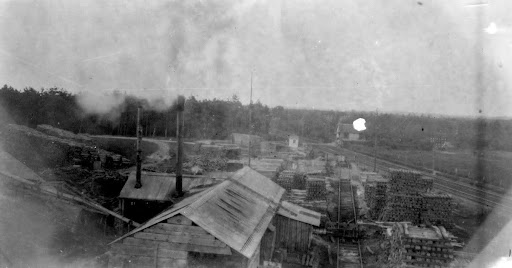
When the country needed it most, the woods workers stepped up. Happy Veterans Day to all and a special thank you to the 367 DCNR employees who have served our country and to all the service men and women who keep us free!
For more information, see:
- World War I: 10th and 20th Forestry Engineers – Forest History Society
- A History of the Pennsylvania State Forest School, 1903-1929 Thomas, Elizabeth H, 1985
- 1895 ~ 1995 The Legacy of Penn’s Woods A history of the Pennsylvania Bureau of Forestry
- Pennsylvania. Department of Forestry, Forests and forestry, Government paperwork. Biennial Report, 1916-1917
About the Author: John Schwartzer
John Schwartzer is the Department of Conservation and Natural Resources Bureau of Forestry woodland stewardship practices specialist. He is a 2008 graduate of The Pennsylvania State University with a B.S. in Forest Science. Before taking on his current role, he was a DCNR service forester for seven years educating and assisting forest landowners in southcentral Pennsylvania. His other previous occupations include research aide, a brief stint as an arborist, and he has been a forest technician for the US Forest Service, PA Game Commission, and DCNR Bureau of Forestry. John lives on a small hobby farm in Perry County PA with his wife Kellie and two sons. If he’s not reading a book, you can find him playing in his woodlot. John is an avid hunter, lackluster angler, wild food/foraging enthusiast, and hopeless gardener.
